12 Talented Researchers
Young diabetes researchers –supported by the Danish Diabetes Academy
12
Talented Researchers
Foreword
At the launching of the Danish Diabetes Academy four years ago, the mission we were given was to ‘find, develop and support talent in the field of diabetes research’.
This collection of 12 researcher profiles demonstrates that the Academy has been successful in achieving those goals. Talent has indeed been developed through a concerted effort on the part of the young people themselves; their mentors, who number some excellent Danish and international researchers; the Novo Nordisk Foundation, who provides funding; the universities and university hospitals; and JDRF, the type 1 diabetes charity.
The young researchers presented in this booklet work on many different aspects of diabetes and have various approaches to treatment. As one of them, Mads Fuglsang Kjølby, says: “We need to have constant improvements for managing diabetes in our therapeutic arsenal”. He himself has already reached admirable research goals. He and five colleagues founded a company for
the commercial development and refinement of new medicines to treat diabetes and obesity.
Manan Pareek will, investigate the effect of fasting blood sugar on the significance of other risk factors for the development of both asymptomatic and symptomatic heart disease.
Line Hjort works with women who have gestational diabetes. Right now, she is on her way to rural Tanzania to discover how we can give children a better start in life by understanding what goes wrong during the vulnerable early period of life in the womb.
Mathias Ried-Larsen’s ambition is to get the patients away from—and keep them away from—hospitals and excessive medication usage by empowering them to sustain a physically active lifestyle.
Adam Hulman wants to identify subgroups at high risk of diabetes who are generally not found through traditional methods, as well as
to facilitate better communication between clinicians and statisticians. One of his results is the online cardiovascular disease risk calculator for patients with type 1 diabetes.
The portraits also tell about the costs: Michaela Tencerova has had to be apart from her husband for three years and she is still very aware of the distance separating her from her parents in Slovakia. Luckily, they are very supportive: “When they saw what my job is about they understood that sometimes it takes some sacrifice to get where you want to be”, she says.
Many of the researchers became interested in the field as a result of a member of their family suffering from diabetes. One of them, Jakob Appel Østergaard, says: “It is something that impacts massively on your life. I don’t think the public are sufficiently aware of this impact. But when someone close to you has diabetes, you want to make things better for them.”
Page 5 Danish Diabetes Academy Booklet 2016
Chinese Honggang Huang is similarly motivated. In China, diabetes numbers have reached catastrophic proportions: 109 million people have the disease. The symptoms of diabetes, combined with the heavy economic burden of treatment, make it difficult for both sufferers and their families to have a decent quality of life.

Signe Schmidt chose to work in diabetes research here because Denmark is leading the research field on many fronts. “Considerable competence in a relatively small geographical area means that exciting synergies are possible. My motivation was the chance to become part of this research network and to work with internationally acclaimed researchers to make a difference”, she says.
Anna Kaufmann Lindqvist wants to have an impact on the treatment and health of the many million people with diabetes – and therefore she wants to take what she learned in academia out into industry. Right now, she is thrilled to be part of a group that shall make bright
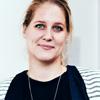



Contents
high-school students interested in working with diabetes.
Pall Karlsson wanted to be a researcher in order to help people diagnosed with amyotrophic lateral sclerosis, like his aunt. Currently, he is working to discover why some patients develop neuropathic pain, as well as researching novel possible therapy targets that could help more patients with diabetes get sufficient treatment for their neuropathic symptoms.
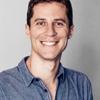

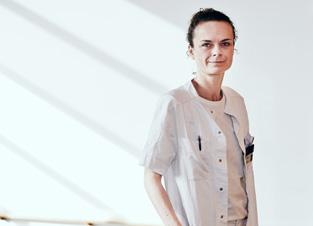
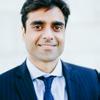
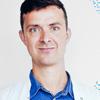
Theresia Schnurr came to the subject from an entirely different angle. It was a pack of sled dogs—and their owner—who made Schnurr a diabetes researcher. In her work with both a Danish and a Greenlandic cohort, she has produced interesting research findings and hopes they will aid in eventually identifying new potential targets for individualised prevention and treatment of obesity and diabetes.
We at the Danish Diabetes Academy are proud of these researchers and of the other 130 people we have been able to support in the four years since
the Academy began its work. Their stories show that the Academy has made an actual difference to them, and we are sure that they in turn will make a substantial difference to the research field and to the lives of patients with diabetes.
The profiles presented here are a mere fragment of the journey of each young researcher. You can follow their future stories at www. danishdiabetesacademy.dk and on Facebook.
Theresia Schnurr page 6
Honggang Huang page 22
Jakob A. Østergaard page 38
Manan Pareek page 10
Signe Schmidt page 26
Mathias Ried-Larsen page 42
Professor Henning Beck-Nielsen Chairman of the Board Danish Diabetes Academy

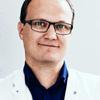
Tore Sønne Christiansen Managing Director Danish Diabetes Academy
Pall Karlsson page 14
Adam Hulman page 30
Michaela Tencerova page 46
Line Hjort page 18
Anna K. Lindqvist page 34
Mads Fuglsang Kjølby page 50
Page 6 Page 7 Danish Diabetes Academy Danish Diabetes Academy Booklet 2016 Booklet 2016
Actually, it was a pack of sled dogs—and their owner—who made Theresia Maria Schnurr a diabetes researcher. And she did not walk into it; she went skiing. It was a lucky punch: In her work with both a Danish and a Greenlandic cohort, she has made interesting findings, and her hope is that they will aid in eventually identify new potential targets for individualized prevention and treatment of obesity and diabetes.
Theresia Schnurr is German, from Bühertal, a small mountain village in the black forest, and she has a Master of Science degree in biochemistry and molecular biology, University of Alaska, Fairbanks, United States.
She studied in Alaska because she had received a sports scholarship to represent the University
of Alaska in cross-country running/skiing during the national university championships.
During her bachelor studies, she had to take some independent research credits and bumped into a young professor who worked with sled dogs in an Arctic setting as an exercise and diabetes model. She worked with her for a semester and soon found out that the research she was doing was not only adventurous—sampling the dogs at -40°C at a dog kennel outside town—but also fun and educational. She learned a lot about insulin resistance and exercise-stimulated GLUT4 translocation.
“When she offered me to do my Master’s thesis in her lab I didn’t hesitate to say yes”, Theresia said.
She did her Master’s and it got her hooked to continue her research, which led to a PhD with the interest in digging further into the health benefits of exercise—which is her personal interest—and obesity/diabetes complications.
Diabetes, obesity and exercise in a genetic perspective
Her Danish boyfriend made her aware of the great PhD conditions in Denmark, and her next luck was that Professor Torben Hansen helped her find funding to work on her PhD project: Diabetes, Obesity and Exercise in a Genetic Perspective.
The overall objective of her PhD project is to elucidate the role of genetics on objectively assessed physical activity and fitness and its
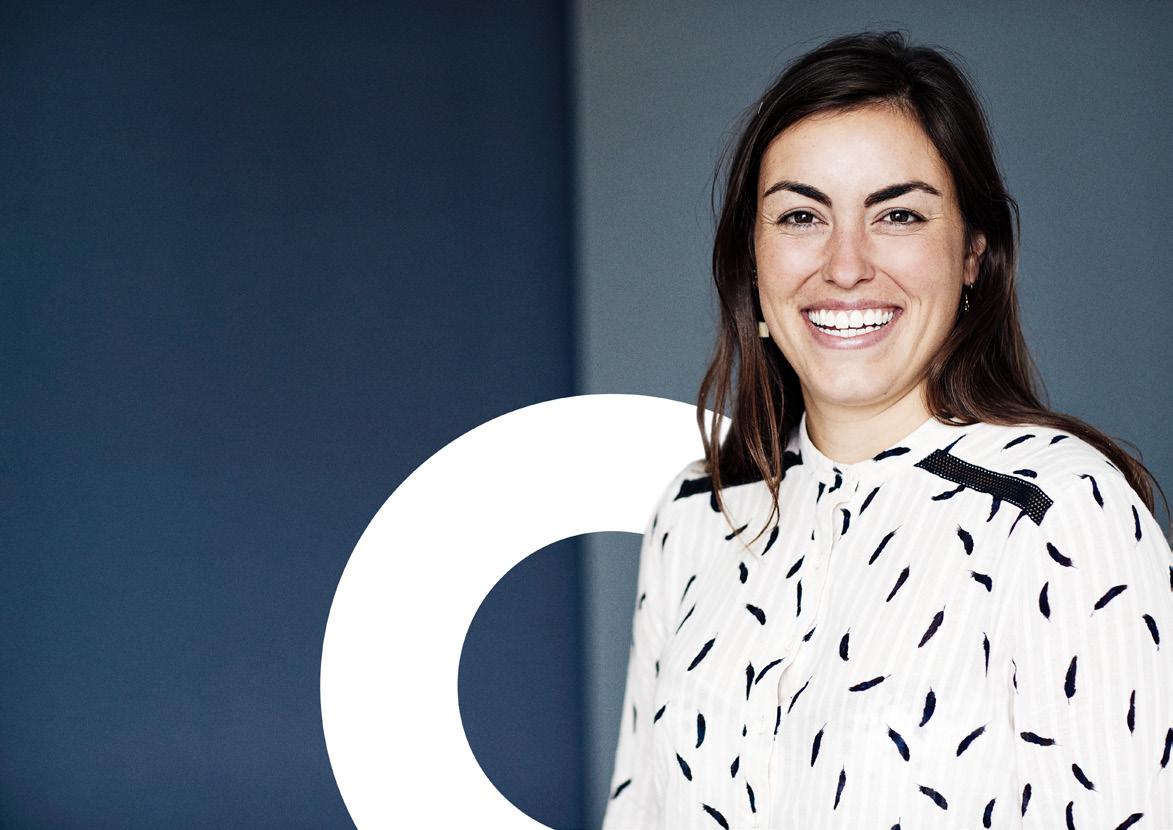
A pack of sled dogs —and their owner— made her a diabetes researcher
Page 9 Danish Diabetes Academy Booklet 2016
Theresia Schnurr
association to obesity and diabetes-related traits. To address her research questions, she is studying well-characterized population-based Danish cohorts as well as a cohort of Greenlandic Inuit for which objectively assessed physical activity data and/or fitness data are available.
Body fat percentage and cardiorespiratory fitness
In one project studying Danish cohorts, she and her colleagues made the potential and very interesting observation that there might be shared genetic aetiology between body fat percentage and cardiorespiratory fitness. In another project they found that Greenlandic Inuit who are homozygous carriers of the TBC1D4 risk variant can greatly benefit from physical activity shown in improved
Facts
Theresia Schnurr, MSc, PhD student at the Danish Diabetes Academy from 2014 to 2017 Nationality: German Project title: The role of genetics on objectively assessed physical activity and sedentary behavior and its association to obesity and diabetes-related traits
Workplace: Novo Nordisk Foundation Center for Basic Metabolic Research, Section for Metabolic Genetics, University of Copenhagen
postprandial two-hour glucose levels, probably through a mechanism involving an exerciseinduced and TBC1D4-independent GLUT4 translocation to the muscle cell membrane.
Theresia believes not only that her PhD project can contribute to eventually identify new potential targets for individualized prevention and treatment of obesity and diabetes, but also that the epidemiological scale of the present study will enable a direct translation of their findings to the real-life setting of populationwide general practice-based diabetes screening and tailored prevention in an Arctic setting.
Still skiing – and mostly training on rollerskis
And as for the skiing, she started up a crosscountry skiing kids group in Copenhagen Skiing Club - the training is of course mostly on
rollerskis. She was also team captain for Team Denmark during the FIS Nordic World Ski Championships in Falun, Sweden, in 2015.
And the Danish boyfriend? He is still her boyfriend. He is working as a attorney -at-law - so it is likely that Theresia will stay and work some more years in Denmark even though she misses spectacular mountains and the snow outside the backdoor.
Principal Investigator: Professor Torben Hansen Consultant: Danish Diabetes Academy, The Virtual Laboratory 2.0, Project: Development of an exercise for high school student to learn about genetic risk for diabetes (03/2015 – present)

LinkedIN profile link: www.linkedin.com/in/tmschnurr
Read more The Virtuel Laboratory www.biotechacademy.dk/ Virtuelt-Laboratorium/V-lab-2-
„I feel really honored and thankful to receive this prestigious award from the Danish Diabetes Academy. It means that hard work pays off and encourages me to continue my research. It makes the hard work of scientists meaningful and of value.”
Page 10 Danish Diabetes Academy Booklet 2016
Theresia Schnurr
Becoming a professor at Harvard is the ultimate goal
A ‘goal-oriented super student’ is how a local newspaper described Manan Pareek when he became the top student at his high school Fåborg Gymnasium, with a grade point average of 11.1. He later became a physician with a grade point average of 11.2, and this year he became one of only 20 especially talented PhD students who received a travel stipend from the Danish Elite Research Initiative established by the Danish Ministry for Higher Education and Science.
For Manan Pareek this is all quite natural. As the child of an academic Indian family, the bar has always been set very high for him, and he always feels a little bit guilty if he does anything that does not improve his CV.
Manan became a physician—in line with the stereotype that this is what Indian parents want for their children—mainly because that is what he wanted. “Flexible job opportunities were important for me, and I have never regretted it”, he says. And he has set his own course: His wildest dream is to become a professor at Harvard or another large American institution. “That would be the ultimate goal”, he says.
He has taken the first step toward Harvard
He has taken the first step—toward Harvard in any case—and has used his Elite Research Initiative stipend to change his daily routine from that of a PhD student at Odense University Hospital and taken a job as a postdoctoral research fellow at Brigham and Women’s Hospital at Harvard Medical School in Boston, United States.
He is conducting research under the supervision of Deepak L. Bhatt, Professor of Internal Medicine and one of the senior researchers in the Thrombolysis in Myocardial Infarction (TIMI) group, a research group which for over 30 years has conducted some of the most essential randomized clinical trials in cardiovascular medicine.
Manan Pareek himself is investigating whether blood tests can be used to predict who may ultimately be affected by a blood clot, an area which his mentor Professor Michael Hecht Olsen inspired him to pursue.
The goal of his spending time abroad is for him to network and have the opportunity of working under the supervision of the world’s leading researchers in the field, he says.

Page 13 Danish Diabetes Academy Booklet 2016
Manan Pareek
Initially, he will be working with his own data, but he later plans to extend his research to include other cohorts, in order to examine new biomarkers which are not currently commercially available. Specifically, with the help of these biomarkers, he aims to continue to investigate the effect of fasting blood glucose on the importance of other risk factors for the development of both asymptomatic and symptomatic heart disease.
“The results can hopefully be used to reveal why, so far, no one has been able to explain the increased risk of heart disease in patients with diabetes based on high blood sugar levels alone”, he explains.
Facts
Manan Pareek, MD, PhD student at the Danish Diabetes Academy from 2014-2017 Nationality: Danish Project title: Detection of Early Atherosclerosis and Arteriosclerosis using Biomarkers and PET/CT (DETECT) in Healthy Controls and Patients with Hypertension, Type 2 Diabetes, or Carotid Artery Stenosis
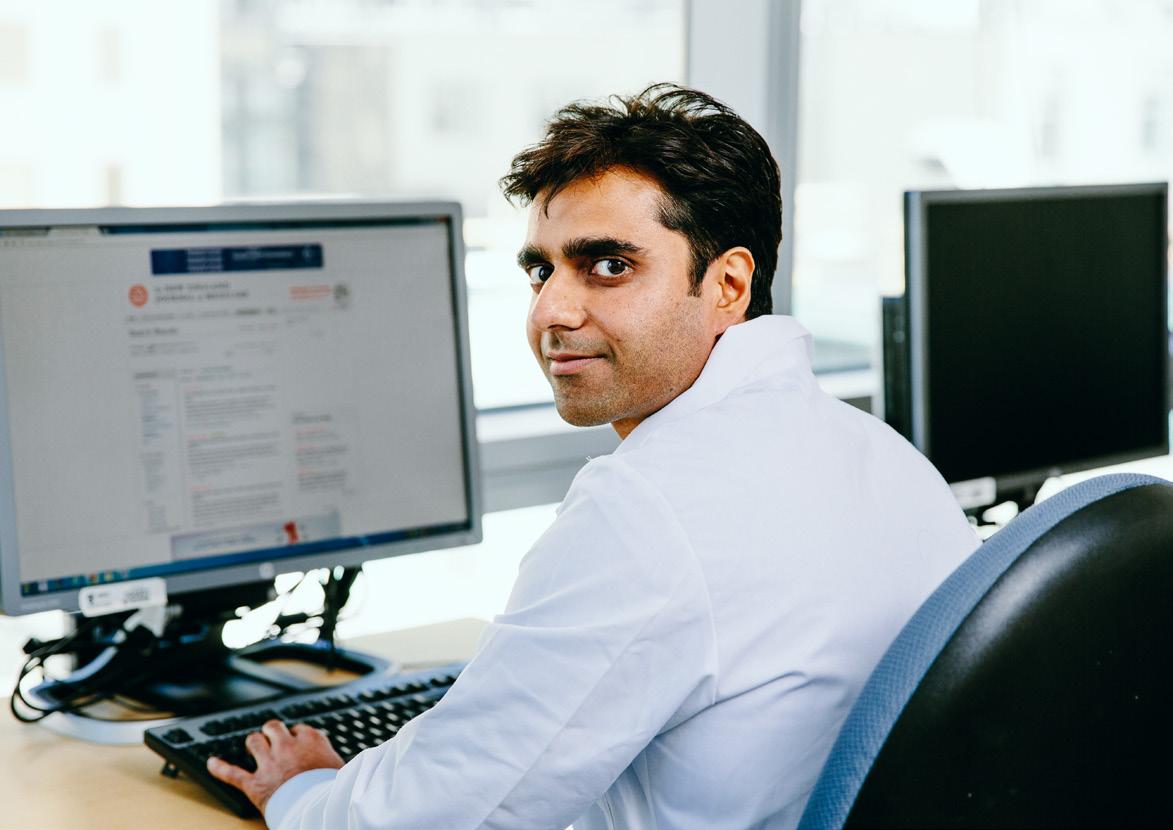
Workplace: Department of Endocrinology, Odense University Hospital
At Harvard, Manan Pareek is dealing with a health and research system very different from that in Denmark. The doctor-patient ratio is more favourable, and there is, therefore, more time to complete research and to instruct younger colleagues. There is often so much time, that for the more complicated cases of certain patients, it is possible to study up on their diseases, be completely familiar with all the issues and develop a thorough plan before presenting it. Of course, this generally more protected environment also has to do with patient security. “We have all heard a few things about the American legal system and the branding of hospitals”, he says.
Interest in diabetes as a research topic
Manan Pareek’s interest in diabetes is primarily research-based, but as a clinician, he prefers cardiovascular medicine and ultimately hopes to work in interventional cardiology.
“Cardiologists must rely on endocrinology, more specifically diabetes research. After all, a large proportion of patients pass through this specialty before crossing a certain threshold and becoming patients with heart disease. Any good prevention strategy must therefore begin with the metabolic disorders preceding the cardiovascular changes which ultimately cause symptoms. The earlier we can identify these high-risk patients, the better the possibility of preventing disease”, he says.
Principal Investigator: Professor Michael Hecht Olsen
Read more:
Manan Pareek’s description of his experiences during his first six months working at Harvard: www.danishdiabetesacademy.dk
„The results can hopefully be used to reveal why, so far, no one has been able to explain the increased risk of heart disease in patients with diabetes based on high blood sugar levels alone”
Manan Pareek
Page 14 Danish Diabetes Academy Booklet 2016
It
day when Pall chose natural science over IT
Pall Karlsson
Pall Karlsson attended school in the north of Iceland, scoring rather mediocre marks. So, his dream of becoming a doctor or researcher – and helping people with amyotrophic lateral sclerosis, like his aunt – looked unattainable. This was his impression, at any rate, until the day he decided to swap IT studies for natural sciences.
“To my surprise, and thanks to terrific and engaged teachers, I started to blossom during biology, chemistry and mathematics classes and my grades quickly went up. I finally knew what I wanted to do and I went for it”, he says.
Pall, now 35, is living proof that dreams are not unattainable. With a Master’s in molecular biology and a PhD in medicine, he has worked at the Danish Pain Research Centre for eight years,

is married and has two daughters. His road to work in the field of diabetes went through neurology and neurological complications, and during his PhD fellowship at the Danish Pain Research Centre he helped implementing the skin biopsy technique, an important tool for confirming the diagnosis of peripheral neuropathy.
“However, while this technique is a terrific diagnostic tool, it doesn’t tell us anything about why the patients have their symptoms nor does it explain why some patients develop chronic pain while others don’t. This is the core of my postdoctoral research at the Danish Diabetes Academy. I want to know why some but not all diabetic patients develop neuropathic pain. Is there a difference between type 1 and type 2
patients with diabetic polyneuropathy? How frequent are neuropathic symptoms in the orofacial region?”
Today the majority of patients with painful symptoms are inadequately treated Another important aspect of his diabetes research focuses on burning pain, one of the most common and devastating complaints of patients with diabetic polyneuropathy. Why do some patients develop this symptom?
“If we can expand the utilization of the skin biopsies and shed some light on the mechanisms behind diabetic polyneuropathy and the reason why some patients develop neuropathic pain that may ultimately have huge implication for our patients”, he says, and explains that the ultimate
was a happy
Page 17 Danish Diabetes Academy Booklet 2016
goal of their research is twofold. “We wish to find out why some patients develop pain so we hopefully can intervene sooner and before the patients develop their symptoms because once the damage has been done it is difficult to reverse it and secondly, we’re hoping that we can locate novel possible therapy targets so more diabetic patients can get sufficient treatment for their neuropathic symptoms”, says Pall Karlsson.
It is important to achieve more knowledge: Today the majority of patients with painful symptoms are inadequately treated and while much is known, many questions remain unanswered in terms of mechanisms and physiopathology
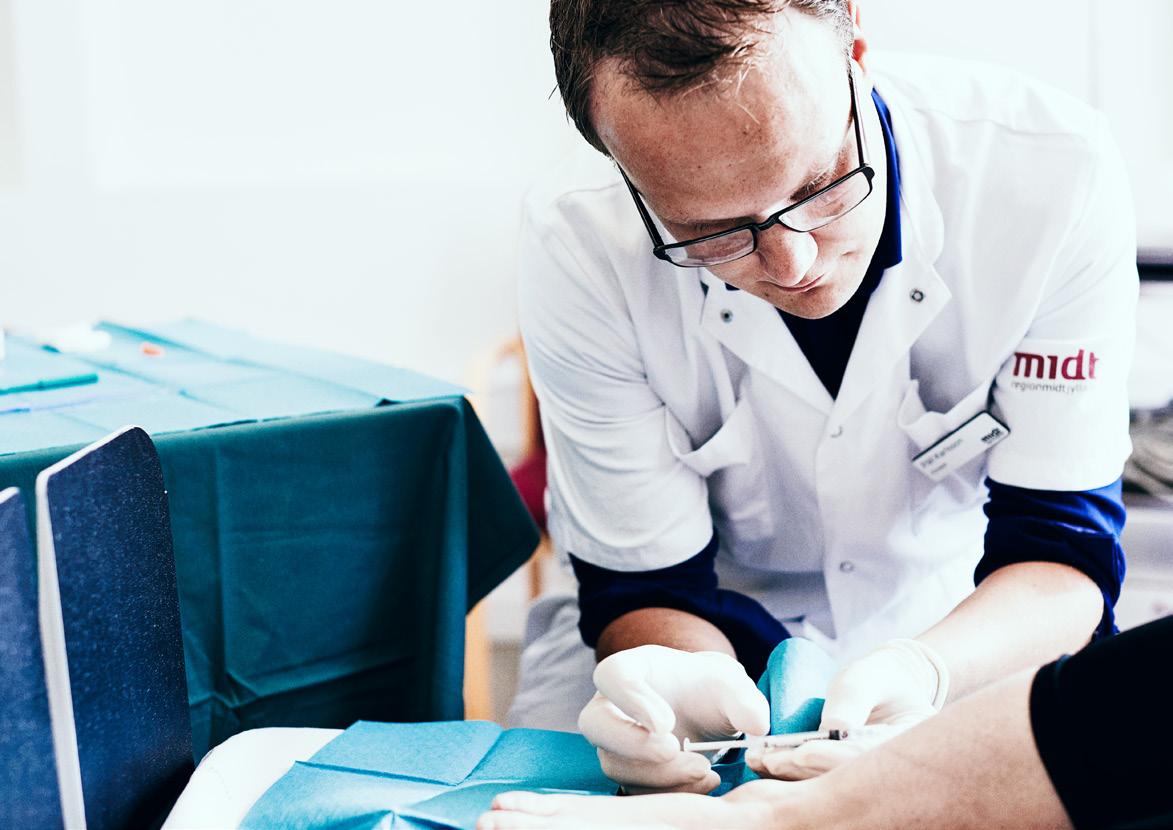
Facts
Pall Karlsson, MSc, PhD, postdoctoral fellow at the Danish Diabetes Academy from 2014 to 2017
Nationality: Icelandic
Project title: Sensory changes, orofacial somatosensory function and nerve fiber analysis on Diabetic polyneuropathy patients and healthy controls
Workplace: Department of Clinical Medicine, Aarhus University Hospital
Has not looked back
He concludes that it took a while for him to take the step and follow his dream. “After I did that I haven’t looked back”, he says. He conducts his research in collaboration with world-known institutions such as the University of Oxford, England, The Johns Hopkins Hospital, Yale University, Michigan University and Washington University, United States, and is regularly abroad on research visits.
Not only has Pall achieved all these things, he has also worked on amyotrophic lateral sclerosis, the illness his aunt suffers from. His MSc, on ‘Vesicle traffic defects in the wobbler mouse and human ALS patients skin fibroblasts’, earned him 12/12. Something his past teachers might well be surprised at!
Principal Investigator: Troels Staehelin Jensen & Professor Jens Randel Nyengaard Consultant
Member of the organizing Winter School postdoc committee in 2015 and 2016
LinkedIN: www.linkedin.com/in/pallkarlsson
„One of the most inspiring Academy courses I have participated in was a presentation course with Barry Stainthorp. The course greatly improved my presentation skills – and shortly after I won the Mogens Fog presentation award ”
Pall Karlsson
Page 18 Danish Diabetes Academy Booklet 2016
Giving up both algae and the Pacific Ocean in favour of gestational diabetes
Line Hjort had a dream of becoming a marine biologist, where she would discover new algae or nudibranch species around the Pacific Ocean. However, following courses in molecular biology and human physiology, she began a rethink. “I discovered how extremely fascinating it was to work in the area of cell biology, DNA and with genes in the laboratory”, she says. Algae have since had to make way for an overriding focus on metabolic disease and, in particular, gestational diabetes.
Line’s current work at Copenhagen University Hospital, Rigshospitalet, involves an investigation of the importance of the first nine months of life for the development—and prevention—of metabolic disorders such as type 2 Diabetes later in life.
Line, 31 years, might not have the Pacific Ocean as her workplace, but she will be seeing plenty of other locations in the world. Starting with Denmark, for example! In 2012-2014, Line travelled the length and breadth of the country conducting a study of 1,200 children and their mothers: this was in connection with a major project on diabetes in pregnancy, itself part of the Danish National Birth Cohort study. “It was an amazing experience,” she says.
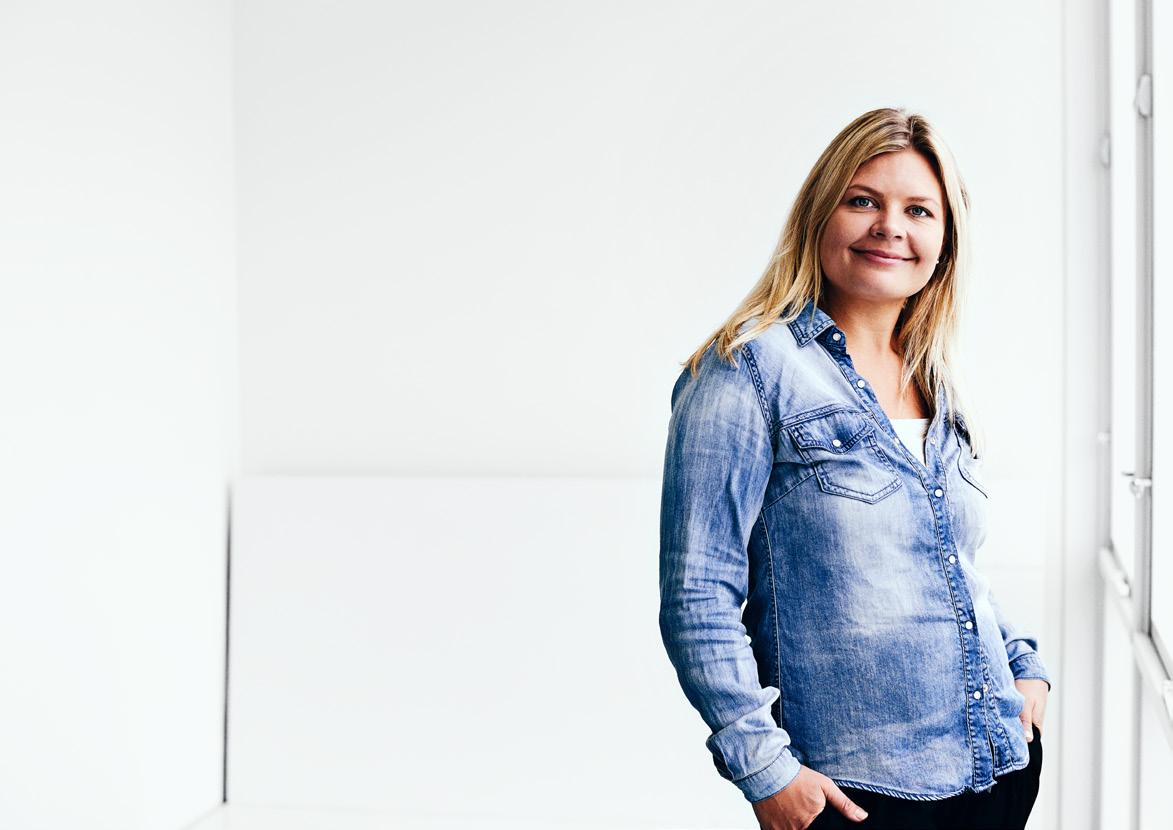
Working in rural Tanzania
She is also part of a Danish government-funded study taking place in rural Tanzania. This study focuses on how anaemia in pregnancy might affect the developmental changes of these children, and her role in this study has been to plan how the epigenetic study and the protocols
Line Hjort
„I learned how to bioinformatically analyze big data sets that are generated when we study genome-wide data —and this is something that I definitely can use in my future studies as postdoc”
Page 21 Danish Diabetes Academy Booklet 2016
Line Hjort
should be implemented locally in Tanzania where she has been teaching the local staff how to obtain placenta biopsies and cord blood samples.
After her PhD, she will work on this project as a postdoctoral fellow and—hopefully—she will we be able to discover how children can be given a better start in life by understanding what goes wrong during the first vulnerable early time period of life in the womb.
Striking it lucky
Line believes that she has been fortunate. During her PhD studies, she was granted the possibility to work eight months with Dr. Richard Saffery at Murdoch Children’s Research Institute, Melbourne, Australia. Dr. Saffery is one of the world’s leading epigenetics experts when it comes

Facts
Line Hjort, MSc, PhD student at the Danish Diabetes Academy from 2013 to 2016 Nationality: Danish Project title: Epigenetic mechanisms in fetal programming by gestational diabetes Workplace: Department of Endocrinology, Rigshospitalet Principal Investigator: Allan Vaag LinkedIN www.linkedin.com/in/ line-hjort-2100744b
to understanding development in children and how epigenetics is involved in disease.
“Specifically, I learned how to bioinformatically analyze big data sets that are generated when we study genome-wide data—and this is something that I definitely can use in my future studies as postdoc”, she says.
Line struck it lucky for the first time when her supervisor Allan Vaag let her do her Master’s project in his research group first at Steno Diabetes Center and then later at Rigshospitalet as a research assistant and PhD student. “I have studied how gestational diabetes, more specifically how an adverse intrauterine environment, may affect the epigenome of the offspring, and if this can be a possible molecular
mechanism behind future metabolic disease among these children. Besides the increased risk of diabetes development later in life among the mothers, several studies have shown that the offspring, too, are at increased risk of developing metabolic diseases. “I learned that the combination of both clinical research as well as molecular biology have great potential for translational research, and I’m greatly thankful for this chance to experience both working with the patients as well as with the samples in the lab”, she says and adds, “Actually, I do believe I’m the luckiest PhD student in the world.”
And algae and the Pacific have not gone by the board—they are subjects that she pursues in her free time.
„I’m greatly thankful for this chance to experience both working with the patients as well as with the samples in the lab... Actually, I do believe I’m the luckiest PhD student in the world”
Line Hjort
Page 22 Danish Diabetes Academy Booklet 2016
Diabetes makes
Honggang Huang has a very good reason for trying to prevent diabetes and improve the treatment of the disease: He was born in a small village in the Hubei province in the central part of China. In his hometown many people suffer from diabetes and related complications, such as stroke and atherosclerosis. The disease and the heavy economic burden for treatment makes it difficult for their families to have a decent life quality.
And it is not only in his village. According to the International Diabetes Federation, there were 109 million cases of diabetes in China in 2015. In other words almost 1 of 10 Chinese adults have diabetes.
His wish to find out both how to prevent and how to treat diabetes brought him to Denmark.
Protein scientist
Honggang Huang is a protein scientist. His research work prioritizes on liquid chromatography mass spectrometry (LC-MS) based protein chemistry, proteomics, protein post-translational modifications (PTMs) method development and the application in diabetes and related complications, such as atherosclerosis.
He had most of his education in China. When he did his master in animal genetics and biotechnology at Chinese Academy of Agricultural Sciences in Beijing, he participated in an EU project, and got to know and collaborate with some excellent professors at University of Copenhagen. “I also had collaboration with scientists in Novo Nordisk R&D Center in Beijing on using animal model
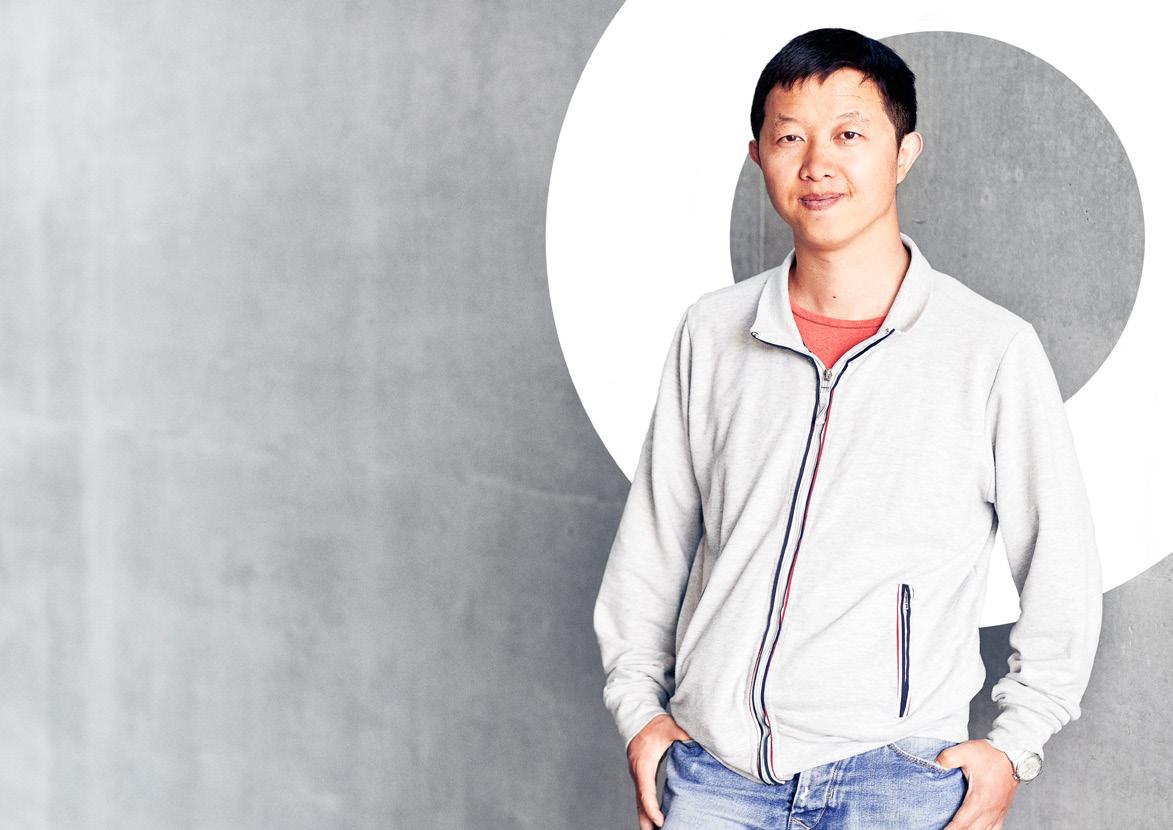
for diabetes in my master and learned that the diabetic research in Denmark is excellent and advanced”, he says.
After finishing his master in 2009, he got a PhD scholarship from University of Copenhagen under the supervision of Prof. Rene Lametsch and later a postdoc under supervision of Prof. Martin R. Larsen at the Protein Research Group, University of Southern Denmark.
“This is one of the leading labs in the world of protein chemistry and proteomics”, says Honggang Huang.
Published in the No.1 journal in proteomics area In his project, he firstly synthesized a novel chemical tag Cysteine-specific Phosphonate Adaptable Tag (CysPAT), and developed an
it difficult for people in his hometown to have a decent life quality
Page 25 Danish Diabetes Academy Booklet 2016
Honggang Huang
efficient method to enrich and analyze diverse reactive oxygen species (ROS) induced cysteine PTMs. “It outperforms other methods for efficient enrichment of cysteine peptides with high specificity (97%), and it attracts industrial interests, such as Thermo Scientific. A US patent (EFS ID 25173836) was filed for this method. The method was further developed for simultaneous enrichment and characterization of multiple PTMs including phosphorylation, Cys PTMs and glycosylation. The paper was published in Molecular Cellular Proteomics (MCP) which is the prestigious No.1 journal in proteomics area”, he tells.
Facts
Honggang Huang, MSc, PhD postdoctoral fellow at the Danish Diabetes Academy from 2013 to 2016
Nationality:
Chinese Project title: Characterization of reactive oxygen/nitrogen species (ROS/RNS)-mediated posttranslational modifications of proteins in diabetes
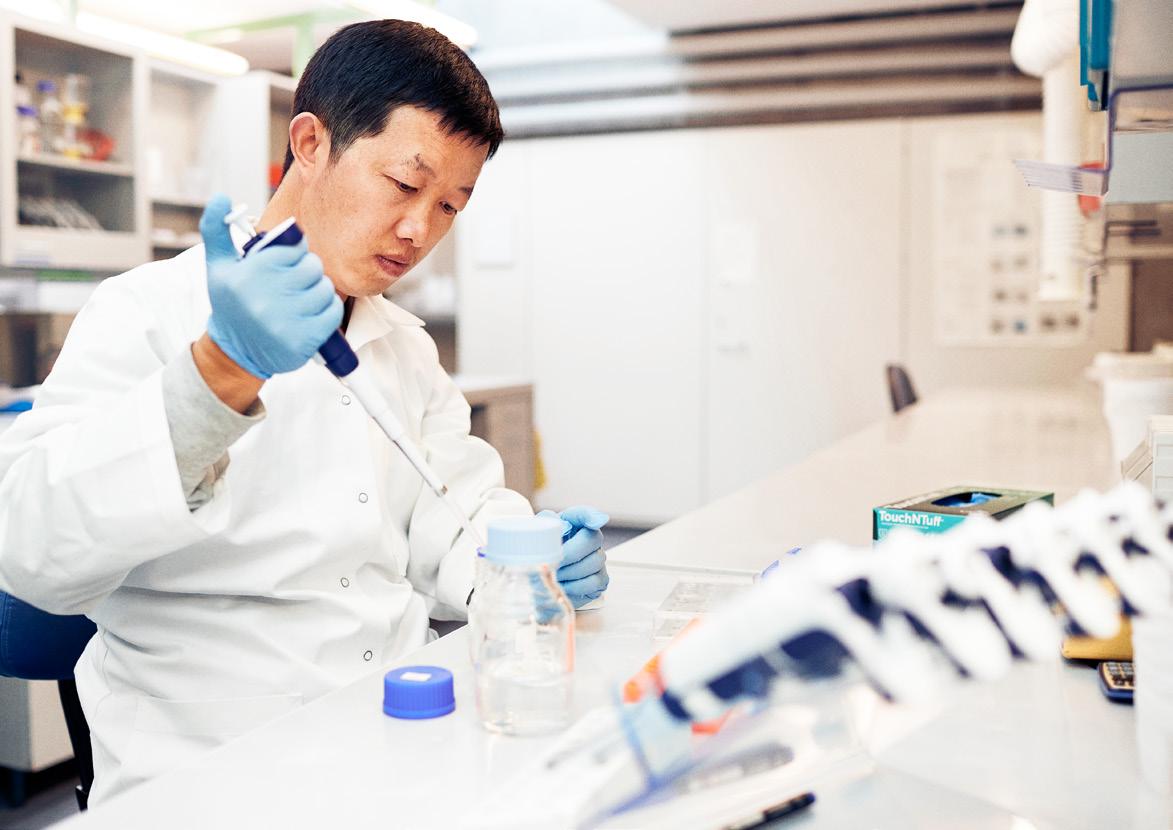
Workplace:
Department of Biochemistry and Molecular Biology, University of Southern Denmark
He stresses, that overall, the CysPAT strategy is a straight forward, easy and promising method for studying redox proteomics and the simultaneous enrichment strategy offers an
excellent solution for characterization of cross-talk of different PTMs.
Beneficial effects of anti-diabetic treatment on atherosclerosis
ROS is known to have fundamental detrimental effects on the development of diabetes and atherosclerosis. Therefore, he used the novel tools he developed to investigate the effects of ROS on proteins and PTMs during the development of diabetes and atherosclerosis. He and medical doctor Prof. Lars Melholt Rasmussen at Odense University Hospital identified some novel proteins and PTM sites, which can be candidate biomarkers or therapeutical targets for diabetes and atherosclerosis. Interestingly, his study also revealed that anti-diabetic treatment for patients with both diabetes and atherosclerosis
can also have beneficial improvement for antiatherosclerosis, compared to atherosclerosis patients receiving only anti- atherosclerosis treatment. They confirmed this finding at protein level, suggesting that some anti-diabetic treatment strategies can also be helpful for patients with atherosclerosis.
Principal Investigator: Professor Martin Røssel Larsen
LinkedIN: www.linkedin.com/in/ honggang-huang-14706121
„I also had collaboration with scientists in Novo Nordisk R&D Center in Beijing on using animal model for diabetes in my master and learned that the diabetic research in Denmark is excellent and advanced”
Honggang Huang
Page 26 Danish Diabetes Academy Booklet 2016
The greatest reward is thanks from a patient
“It’s great to have a publication accepted, to be cited or to hear that your research findings have changed treatment practices; but for me, the very best reward is to be thanked by a patient.” So says Signe Schmidt, a doctor at Copenhagen University Hospital Hvidovre. Her medical background shines through her every statement. It is her ongoing desire to be of help to other people, and even though her personal life is satisfying and engaging, she says, “Maybe it sounds a bit nerdy, but since I began research in 2009, I have thought about diabetes every single day.”
For her PhD, Signe focused on type 1 diabetes; she is continuing on this track in her postdoctoral work. “There is no doubt that I will be a better researcher thanks to my postdoc appointment than if I had to pursue my research interests alongside full-time
employment as a clinician”, she says, pointing to further advantages that the Danish Diabetes Academy has provided: “The grant gives me time to guide younger colleagues; I can help improve the diabetes research milieu; I have the opportunity to further develop research skills and be immersed in and expand my field of research.” Signe is also grateful for her membership of the Academy. “It gives me access to a series of events in the profession, where some of the best researchers in the world present and discuss their latest findings. I am often there, even if the subject is slightly outside my field of research, because the dividends in terms of professional contacts and networks are high.”
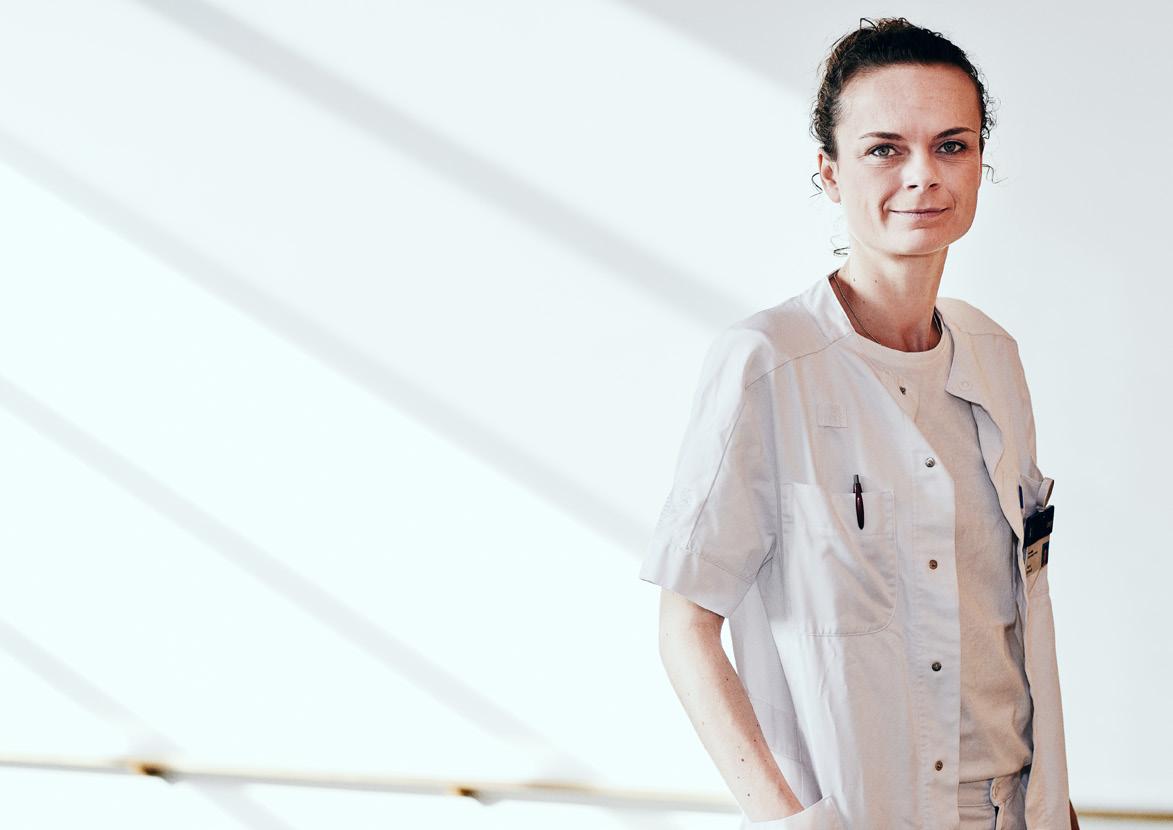
Signe Schmidt
„Maybe it sounds a bit nerdy, but since I began research in 2009, I have thought about diabetes every single day.”
Page 29 Danish Diabetes Academy Booklet 2016
Signe Schmidt
Facts
Signe Schmidt, MD, PhD, postdoctoral fellow at the Danish Diabetes Academy from 2013 to 2017 Nationality: Danish Project title: Closed-loop and type 1 diabetes Workplace: Department of Endocrinology, Copenhagen University Hospital Hvidovre
Principal Investigator: Chief Consultant Kirsten Nørgaard Awards:
Prevention and treatment of hypoglycaemia
What concerns Signe most right now is partly the opportunities for using mini-dose glucagon for the prevention and treatment of hypoglycaemia in patients with type 1 diabetes; and partly the significance of carbohydrates in the diet in relation to glucose metabolism in the same patient group.
“I focus on measures that can be directly applied to treatment and technologies that may be used in the future. Throughout the work, we must take into account the risk of hypoglycaemia, patients’ satisfaction with the treatment and their weight development”, she says.
Signe values the close contact with patients: “It’s immensely rewarding and a constant reminder of how important my work is and the potential
difference I can make to other people’s lives”, she concludes.
An amalgamation of skills in a small geographical area
Signe chose to work in diabetes research because Denmark leads this field on many fronts.
“Considerable competence in a relatively small geographical area means that exciting synergies are possible. My motivation was the chance to become part of this research network and to work with internationally acclaimed researchers to make a difference to the growing number of people diagnosed with diabetes”, she says.
And she has succeeded in her aims. With support from the Academy, Signe completed 12 months of research training at Harvard Medical School. “The teaching was world-class, and it
gave me considerable knowledge of research methodologies”, she says. Other initiatives of the Academy have also helped Signe establish contacts with Danish and foreign research institutions and she expects that these will lead to future academic and industrial collaboration.
Signe’s ‘nerdiness’ in thinking about diabetes— and the questioning mindset that is at the heart of all research—creates results that can optimize treatment. And if at any time she feels inclined to stop questioning, she has only to look to her 15-month old boy for inspiration.
“I love watching him exploring the world. He investigates, trying to understand all those things I take for granted.”
The 2013 research scholarship from the Danish Diabetes Association
LinkedIN: www.linkedin.com/in/ signe-schmidt-2641676
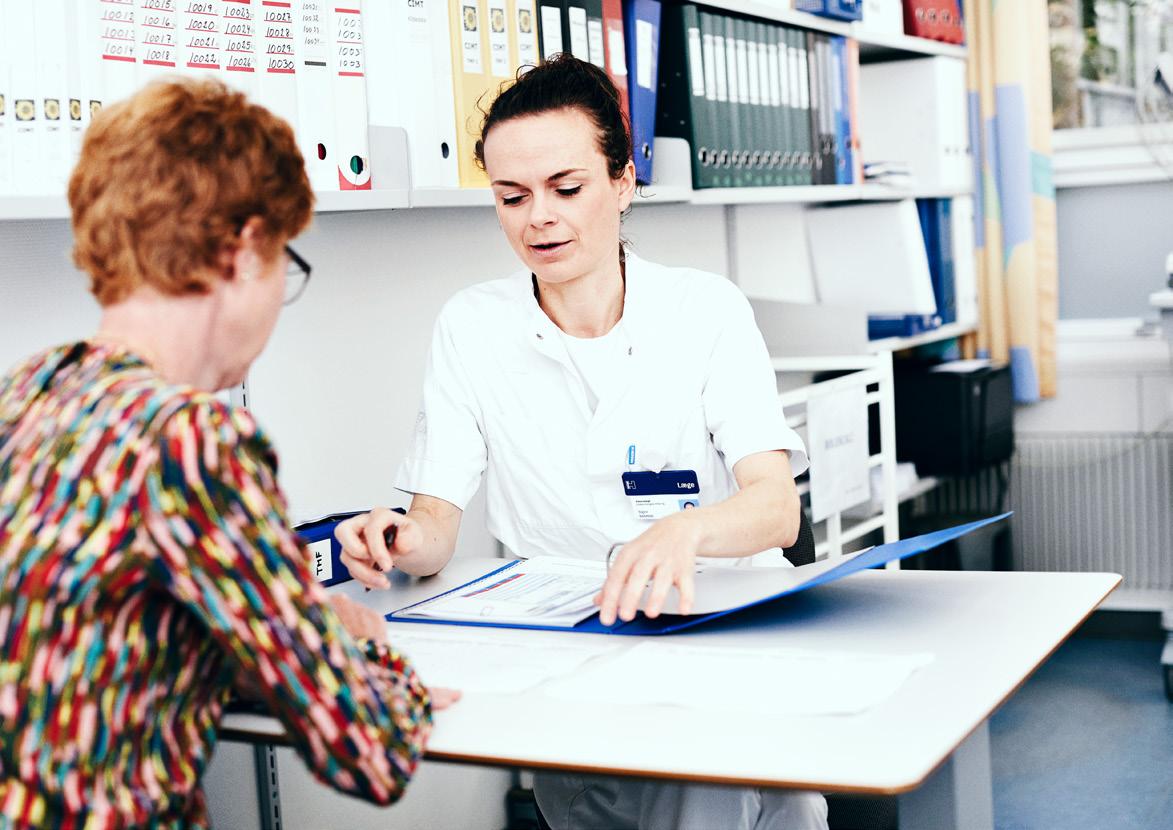
„I focus on measures that can be directly applied to treatment and technologies that may be used in the future. Throughout the work, we must take into account the risk of hypoglycaemia, patients’ satisfaction with the treatment and their weight development”
Signe Schmidt
Page 30 Danish Diabetes Academy Booklet 2016
An accomplished speaker of an unusual tongue: the R statistical programming language
Adam Hulman speaks Hungarian, English and German and is learning Danish. And there is another string to his bow: a language he uses on a daily basis but one that few people master—the R statistical programming language. He first encountered R in Germany at the University of Paderborn, as an Erasmus student in 2008. Now he uses the language at the Section for Epidemiology at Aarhus University to apply innovative statistical methods to explore risk factors and outcomes related to diabetes.
He is an epidemiologist (PhD) and applied mathematician (MSc), motivated by the wish to understand complex systems that drive the health of populations. High on the list of aims he hopes to achieve is to identify subgroups at high risk of diabetes that remained unrevealed with traditional methods plus facilitate to better
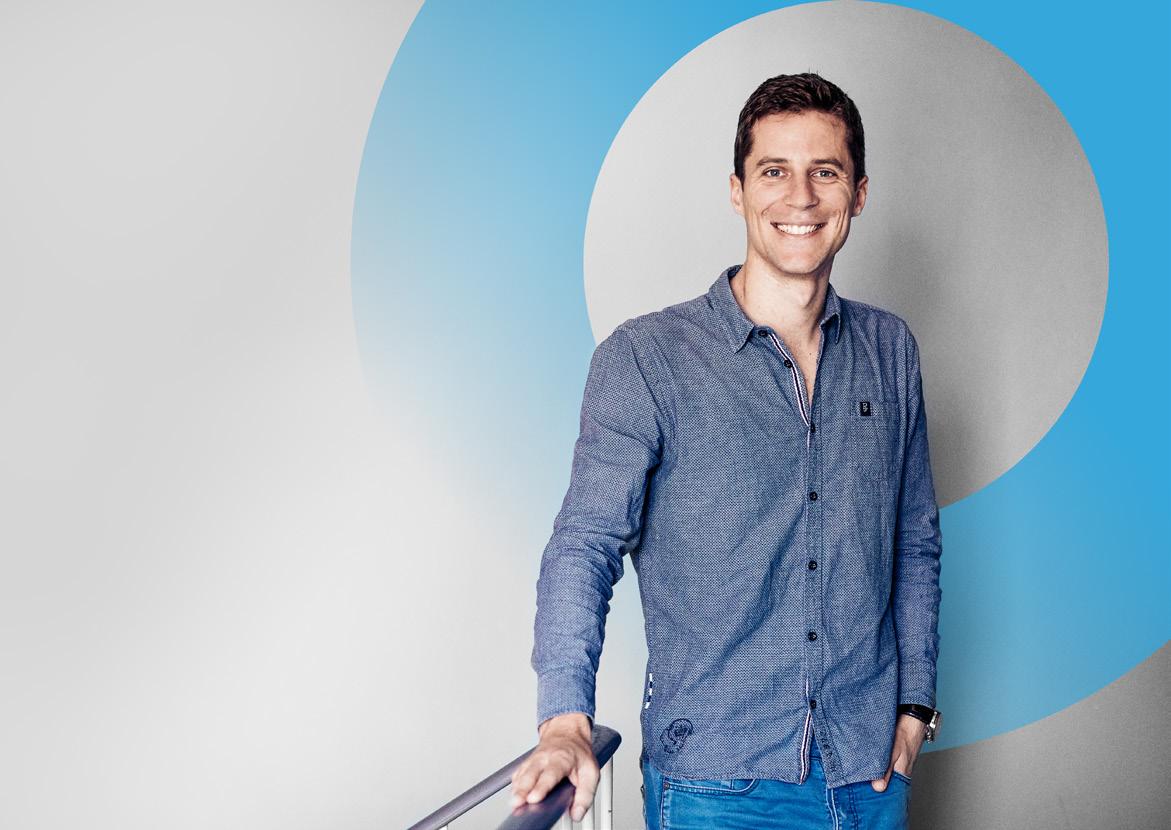
communication and knowledge transfer between clinicians and statisticians.
When asked about his aims, Adam is ready with a list:
• to introduce and apply state-of-the-art statistical methods to contribute to quality improvements in epidemiological research;
• to apply innovative methods to explore risk factors and outcomes related to diabetes; and,
• to ensure knowledge translation: ultimately to assist personalised risk prediction and prevention.
Developed the online risk calculator for the Steno T1 Risk Engine
Adam works on a broad range of projects and has already demonstrated that he can achieve interesting results with clinical
relevance. Amongst his past achievements is the development of the online risk calculator for the Steno T1 Risk Engine, an application for cardiovascular disease risk prediction for patients with type 1 patients. “Prediction models are abundant in the epidemiological literature, validation is seen less often, but translation into clinical practice is really rare”, he says.
Other achievements include a recent publication, with Adam as lead author, in Endocrine on the heterogeneity of glucose response curves during an oral glucose tolerance test. “We identified five different patterns with a statistical method called latent class analysis and found that the cardiometabolic risk profiles of the groups were remarkably different. This fits well with the current notion that diabetes is a heterogeneous disease and may reflect different underlying
Page 33 Danish Diabetes Academy Booklet 2016
Adam Hulman
physiologies that need to be investigated further. Also, these patterns have to be linked to longterm outcomes before our results can have an impact in a clinical setting”, he says.
He also conducted a similar study in a cohort of Asian Indians. “Their (Asian Indians') diabetes risk is higher than in other ethnic group. Why? This is something I would very much like to investigate and translate into clinical practice: maybe they could benefit from different interventions.”
Mentee of Professor Daniel Witte
Adam was lucky enough to meet Daniel Witte, Professor of Diabetes Epidemiology at Aarhus University under a Danish Diabetes Academy grant. By chance they met in London, and Daniel became his mentor and main PhD
Facts
Adam Hulman, MSc, PhD, postdoctoral fellow at the Danish Diabetes Academy from 2015 to 2018 Nationality: Hungarian Project topic: Diabetes Epidemiology and Biostatistics
supervisor. It was Daniel who introduced Adam to diabetes epidemiology.
Daniel Witte was the leader of the epidemiology group at Steno Diabetes Center at that time, which gave Adam the opportunity to develop a scientific network in Denmark from an early stage of his career, while he completed his PhD in Hungary. “Many researchers from Steno Diabetes Center are still my strongest collaborators and play an important role in my research”, he says.
Adam has also succeeded in creating strong collaborations within the Danish Diabetes Academy, among others with Visiting Professors Rebecca K. Simmons (University of Cambridge, United Kingdom) and Venkat Narayan (Emory University, Atlanta, United States) who became now collaborators on various projects.

After finishing his PhD, Adam went to McMaster University, Canada, to take up a postdoctoral position to investigate the role of maternal obesity and weight gain on pregnancy outcomes, but when Daniel Witte started to work at Aarhus University in January 2015 as a Danish Diabetes Academy Professor and was looking for a postdoctoral fellow, Adam considered it as a good opportunity to return to Europe, diabetes research and join Daniel's team.
His plans are clear-cut: he wants to create his own group within five years. Where this will happen, however, is less certain. ”I would be happy to stay in Denmark for the long-term, but would not exclude the option to return to Hungary at some point and take the gained experience home”, he says and adds, “No matter what, I will keep my strong international collaborations.”
Workplace: Department of Public Health, Aarhus University Principal investigator: Professor Daniel Witte Google Scholar profile: goo.gl/MTk8Gb
Read more: www.steno.dk/T1RiskEngine
„Their (Asian Indians') diabetes risk is higher than others. Why? This is something I would very much like to investigate and translate into clinical practice: maybe they could benefit from other interventions.” Adam Hulman
Page 34 Danish Diabetes Academy Booklet 2016 Page 35
Helping recruit new diabetes researchers
Anna Kaufmann Lindqvist
Anna Kaufmann Lindqvist is thrilled to be part of a group that will make bright high-school students interested in working with diabetes. The project sets out to awaken awareness of the specialist area of diabetes in biotechnology, biology and sports pupils. Meetings with diabetes researchers will draw attention to the possibility that their future may well be linked to the field of diabetes.
Alongside the Danish Diabetes Academy and the University of Southern Denmark, the project enjoys the support of Svendborg Erhvervsskole (technical and vocational school) and 15 primary and secondary schools within the Region of Southern Denmark.
Anna Kaufmann Lindqvist’s specific contribution to this project is the development
of a ‘virtual laboratory’: a software programme explaining diabetes research. In the first instance, it is designed for 1,350 students and their teachers. If it proves successful, the programme can be offered to secondary and lower secondary schools throughout Denmark.
Anna is quite certain about the impetus that drove her towards diabetes research: “I have always been intrigued by the complexity of the human body and how certain factors can interplay to cause disease”, she says.
Started with medicine but changed to biology
Swedish-born Anna Kaufmann Lindqvist started her university studies at The Faculty of Medicine University of Copenhagen, but after a period of soul-searching she came to the conclusion that this was not the path for her.
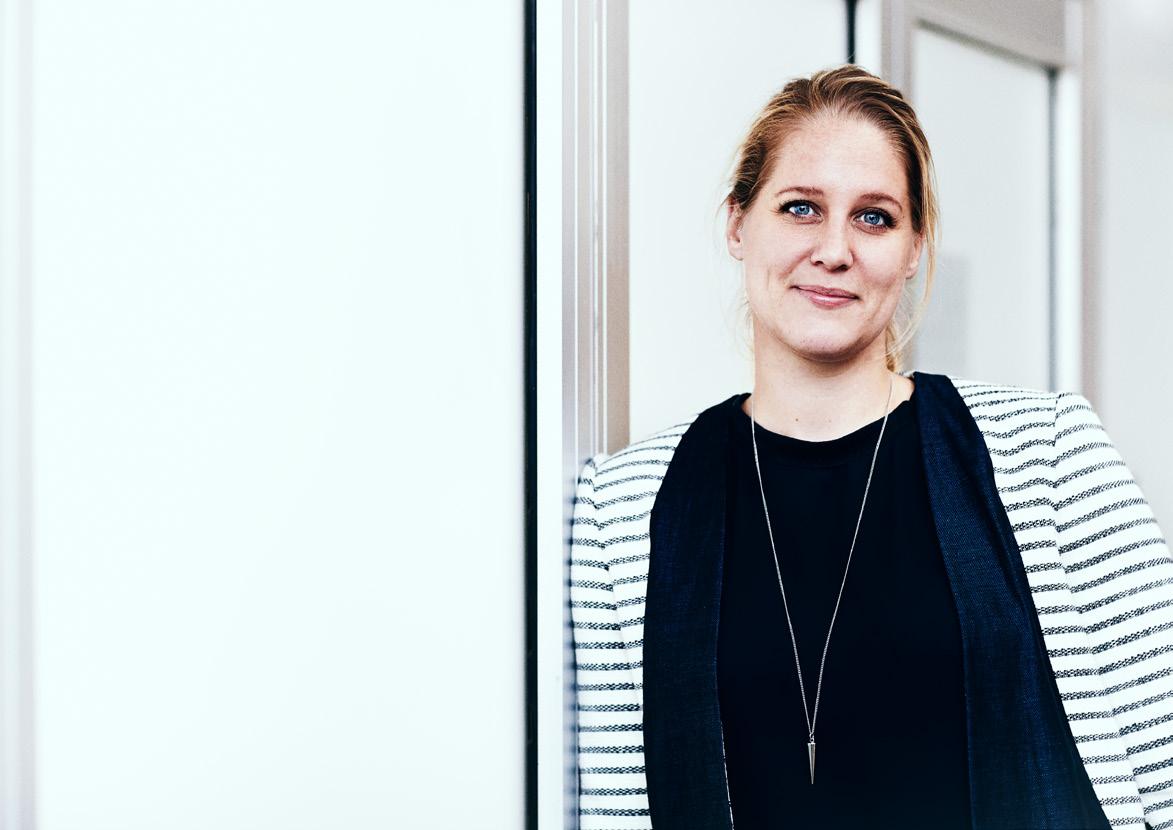
„I have always been intrigued by the complexity of the human body and how certain factors can interplay to cause disease”
Page 37 Danish Diabetes Academy Booklet 2016
Anna Kaufmann Lindqvist
She was much more interested in the molecular and cellular changes that occur in the body and therefore changed direction somewhat and started studying at the Department of Biology, University of Copenhagen. During her Master’s thesis, she studied pancreatic cancer cells and became fascinated by the pancreas. Alongside her Master’s studies, Kaufmann Lindqvist also worked with cultivation of different cell lines, such as muscle cells.
Her aim is clear: To contribute to the understanding of diabetes and, in that way, have an impact on the treatment and health of so many people worldwide. Her specific contribution to the current effort is her PhD. “My aim has been to induce angiogenesis and investigate the consequences to
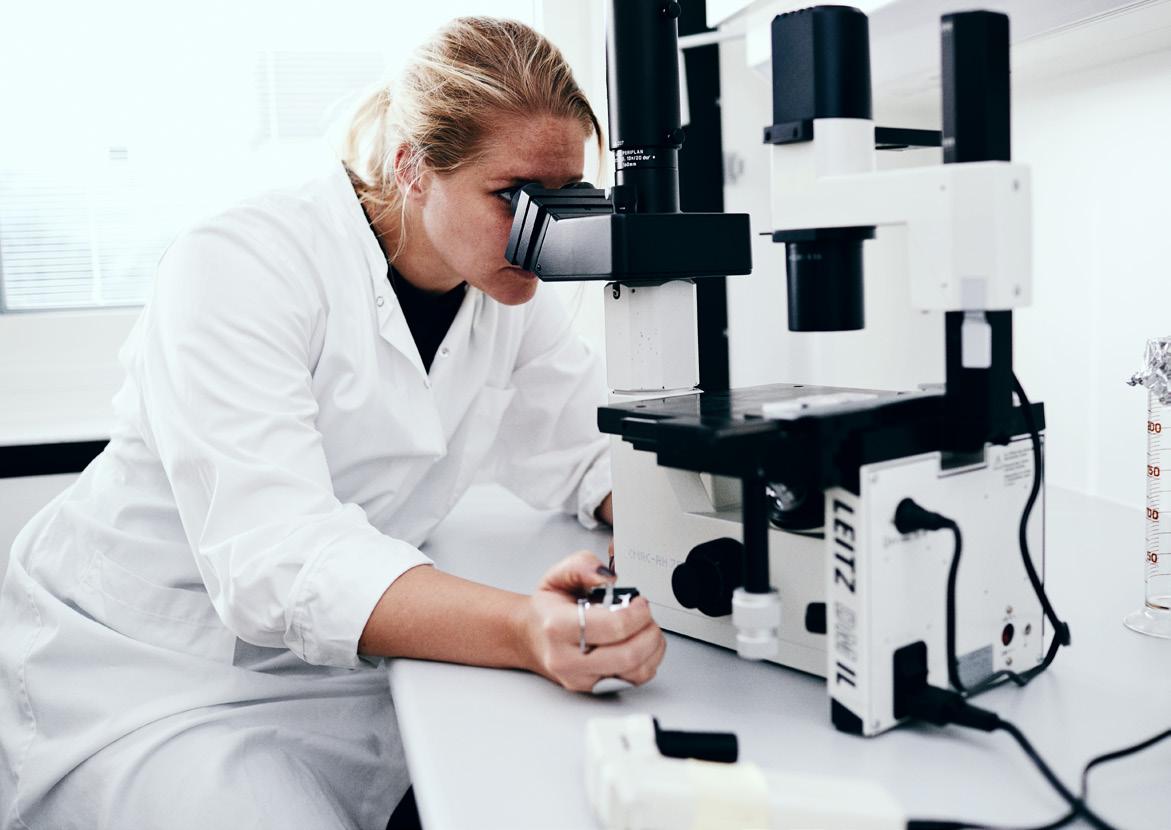
Facts
Anna Kaufmann Lindqvist, MSc, PhD student at the Danish Diabetes Academy from 2013 to 2016 Nationality: Swedish Project title: Skeletal muscle angiogenesis and its relation to insulin sensitivity
Workplace: The Department of Nutrition, Exercise and Sports, University of Copenhagen
Principal Investigator: Professor Ylva Hellsten
insulin-stimulated glucose uptake in skeletal
muscle”, she says.
While adding to the knowledge of type 2 diabetes and insulin resistance, her research could also contribute to a new treatment approach in early onset insulin resistance as a preventive measure to developing diabetes: “We have been able to show that medically induced skeletal muscle specific angiogenesis in rats and humans improve insulin sensitivity. In both animal and human trials, I have primarily worked with hyperinsulinemic euglycemic clamp, and I have investigated the endothelial cell contribution to the observed phenomenon”, Anna Kaufmann Lindqvist says.
Will take knowledge out into industry
Anna Kaufmann Lindqvist has already decided what she wants to do next: “After finishing my PhD, my goal is definitely to take what I have learnt in academia out into industry. Other than that, my work with The Virtual Laboratory also influences my wishes..… actually, I would love to continue working with communicating scientific data.” And how will she summon the energy to do this?
By summoning a lot of energy. “I am a devoted cross-fitter and I am running my first Obstacle Course Race (toughest) this fall. As a biologist I love nature and animals and I often go frog scouting with my son. And if we find a Pokemon or two, that’s just a bonus.”
Read more: The Virtuel Laboratory www.biotechacademy.dk/ Virtuelt-Laboratorium/V-lab-2-1
LinkedIN www.linkedin.com/in/ annakaufmannlindqvist
„My aim has been to induce angiogenesis and investigate the consequences to insulin-stimulated glucose uptake in skeletal muscle”
Anna Kaufmann Lindqvist
Page 38 Danish Diabetes Academy Booklet 2016
Jakob Appel Østergaard faces a very considerable challenge: having completed a postdoctoral assignment, he must embark on his main educational topic: endocrinology. In his own words, he must leave one fantastic area of work to go to another, equally fantastic one. The challenge will be to have to choose, when in fact he would like to pursue both things. “I am looking forward to applying my knowledge to clinical practice, but I dread the possibility that there won’t be time enough to do research”, he says.
Jakob is aware of his obligation to continue research, something he owes to himself, the Danish Diabetes Academy and the Novo Nordisk Foundation and other contributors, who have made the investment in him, and
he wants to retain the connection with the Danish Diabetes Academy and participate in the symposia and workshops as well as the expanded network it provides.
It has always been his dream to continue as a researcher, so the challenge consists in finding a solution that allows him to combine this with his clinical work. It will be hard, especially since he must also find time for home life with his wife Lisbeth, a nurse anaesthetist, and their daughters aged five and seven.
Something that counts in his favour is that, unlike others who have had to give up their research, he already has his postdoctoral fellowship behind him. “The three years I spent on the postdoc in
the Danish Diabetes Academy have helped me build a great network and I envisage plenty of exciting projects, so my odds have become much, much better. One the other hand, I can`t do research only in my free time for the rest of my life. This will be a tipping point”. He is, however, admirably optimistic that systems will change to prevent a lot of research from falling by the board when students finish their postdoctoral or PhD work, and that it will be possible for them to carry projects through.
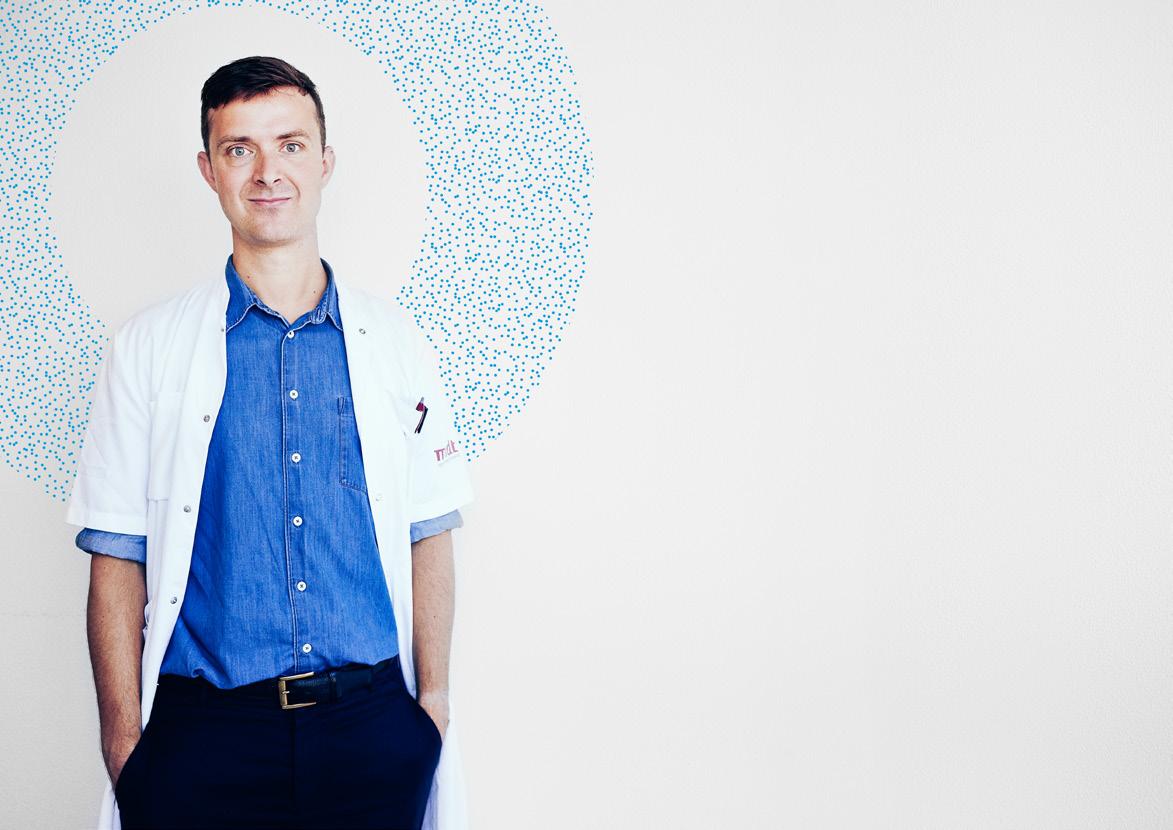
Jakob Appel Østergaard
Page 41 Danish Diabetes Academy Booklet 2016
Jakob’s big challenge: too little time for research
Facts
Jakob Appel Østergaard, MD, PhD, postdoctoral fellow at the Danish Diabetes Academy from 2013 to 2016
Nationality: Danish Project title: The complement system in kidney disease.
Workplace: Department of Endocrinology and Internal Medicine, Aarhus University Hospital
Principal Investigator: Professor Troels Krarup Hansen

Diabetes has a massive impact on people’s lives
The subject of Jakob’s research is diabetic kidney disease. And the reason for his choice of specialism is partly that both his brothers have type 1 diabetes. “So, I have seen close up what it means to have diabetes. It is something that impacts massively on your life. I don’t think the public are sufficiently aware of this impact. But when someone close to you has diabetes, you want to make things better for them”, he says.
What particularly interests him in diabetes is the risk of complications. How do these connect with the disease itself? What exactly is happening?
Jakob turns to military terminology when describing his research. “In war, they speak of
friendly fire when an army shoots at their own troops by mistake. What our research group has identified is that the body’s own weaponry, the immune system, seems to be mistaking its own cells for those of invading bacteria. So, when it opens fire, the body’s cells are hit; this seems to be happening in the development of diabetic kidney disease”, he concludes.
Around 30 per cent contract kidney problems
Jakob’s aim is to discover a means of deflecting or at least mitigating the attacks on the body’s own cells. This, he feels, would mean a healthier, better quality of life for a lot of diabetes sufferers. Nearly 30 per cent of patients with type 1 or type 2 diabetes are affected by varying degrees of kidney problems. “The research perspectives are very promising. A number of drugs that control
the immune system have already been developed. It is reasonable to speculate that they could be applied preventively in the case of diabetes patients”, Jakob says.
When asked about further goals, Jakob does not hesitate: “I hope that the road I’m on now will prove to have been the right one when I come to my retirement. My task now is to test my hypothesis and continue working on preventing damage. The ultimate dream is that these immune system ‘inhibitors’ can be used by people with diabetes. And in the short-term view, I would like to be able to describe the mechanisms involved. This is a realistic short-term aim.”
Read more: The 2014 research grant from the Danish Diabetes Association and the Danish Diabetes Academy’s prize for Best Clinical Researcher 2014.
LinkedIN www.linkedin.com/in/ jakob-appel-østergaard-b0630b70
„The ultimate dream is that these immune system ‘inhibitors’ can be used by people with diabetes. And in the short-term view, I would like to be able to describe the mechanisms involved. This is a realistic short-term aim.”
Page 42 Danish Diabetes Academy Booklet 2016
Jakob Appel Østergaard
Patients should move away from using hospitals and medications and get some exercise prescribed instead
How little movement is required to reduce the risk of type 2 diabetes, and can an exercise programme really be used as a treatment and/ or cure for type 2 diabetes? These are the two main questions Mathias Ried-Larsen asks himself in his research, and he already has part of the answer: A review of 17 domestic and foreign research projects, which he conducted, has concluded that if one interrupts lengthy sedentary periods with just a little movement, it appears to have health-promoting effects on many inactive and/or overweight persons.
“Our message to those who don’t get much exercise is that they should not give up, because it’s not impossible. It’s not a question of how much time you spend sitting that is important, but how you sit. If you just get on your feet and
move around a little”, says Mathias Ried-Larsen, who hopes that moving around a little may make you want to get more exercise. “If movement is medicine, which still has yet to be demonstrated, a little physical activity and interrupting sedentary activities could be a gateway drug”, he says.
“Although this is good news, it may require a larger effort to move patients away from – and keep them away from – hospitals and excessive use of medications. Therefore, I seek to empower patients to sustain a physically active lifestyle. This requires continuously developing and testing feasible lifestyle-based treatment strategies which are at least as efficient and safe as standard care. To ensure effectiveness, these strategies should be developed and tested in the environment where they are used. One important aspect of

Mathias Ried-Larsen
„If movement is medicine, which still has yet to be demonstrated, a little physical activity and interrupting sedentary activities could be a gateway drug”
Page 45 Danish Diabetes Academy Booklet 2016
Mathias Ried-Larsen
my research includes communicating research results to the public, in acknowledgment that practice can be reformed by both those who perform and those who require treatment. I aim to have my research acknowledged and understood by clinicians as well as by patients and policymakers”, says Mathias Ried-Larsen.
Lifestyle interventions
Mathias Ried-Larsen works with lifestyle intervention at Copenhagen University Hospital, Rigshospitalet, for the project U-TURN. Lifestyle intervention is recognized as first-line treatment in type 2 diabetes as a supplement to pharmacological treatment. However, type 2 diabetes is regarded as an irreversible condition requiring increasing use of medication over a lifetime, with the accompanying side effects
Facts
Mathias Ried-Larsen, MSc, PhD, postdoctoral at the Danish Diabetes Academy fellow 2013-2016
Nationality: Danish Project title: Implementation of the DD2 exercise program in Danish Municipalities
Workplace: Center of Inflammation and Metabolism, Rigshospitalet, Copenhagen Principal Investigator: Professor Bente Klarlund Pedersen
and multimorbidity. There is an increasing body of evidence suggesting that type 2 diabetes conditions can be reversed using gastric bypass, for example. Although lifestyle intervention is efficient in regulating blood sugar, no studies have shown that it can replace pharmaceutical treatment for type 2 diabetes or cure the disease.
“If it can be shown that lifestyle intervention is equivalent to pharmaceutical treatment or can reduce or eliminate the need for medication, this study will provide patients and physicians with a real alternative to standard disease management”, Ried-Larsen says.
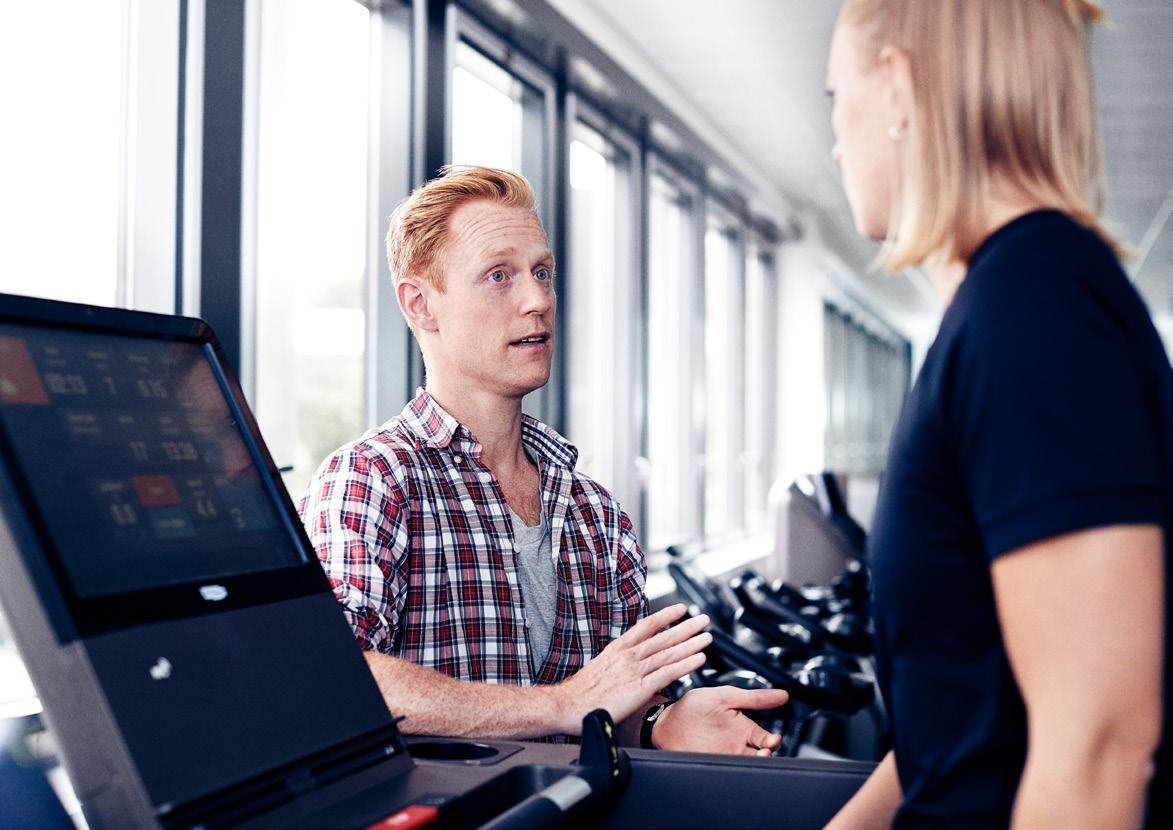
Relationship between work and private life
There is a strong relationship between Mathias’s work and his private life. He had a career in gymnastics for over 20 years, both as a gymnast
and as a coach, but he had to stop after he had some injuries. Now he rides mountain bike a few times a week, plays beach volleyball, runs and does ‘whatever comes along’. He and his wife Anja take active vacations together, going hiking, doing water sports, for example. And he is about to initiate three-year old Alberte and five-year old Karla into the joys of the outdoor life—the pleasure of lying in a tent and having everything you need, but in a backpack.
Even if he is taking his own medicine—or rather attempting to share his own joy in physical activity—he does not do as he says. He could never, never imagine living a life where he only got up a few times an hour and moved around a little. But he is enthusiastic about telling patients that indeed so little can change so much …
LinkedIN: www.linkedin.com/in/ mathias-ried-larsen-a191818b?
„If it can be shown that lifestyle intervention is equivalent to pharmaceutical treatment or can reduce or eliminate the need for medication, this study will provide patients and physicians with a real alternative to standard disease management”
Mathias Ried-Larsen
Page 46 Danish Diabetes Academy Booklet 2016
Michaela Tencerova is a single child and conscious of the fact that whilst she lives and works on Funen, Denmark, her parents are a long way off in Slovakia. They can skype, of course, and it could be worse: Like when she lived in Worcester in the United States. But it is still sad for them all that they seldom meet up. Luckily, Michaela’s parents are extremely supportive. “When they learned what my job is about, they understood that sometimes you have to make sacrifices to get to where you want to be”, she says.
Michaela also had to live thousands of kilometres away from her husband for three years. The great advantage for her of Funen is not just the exciting research opportunities, but also that they are together again. He is a doctor at Odense University Hospital and she
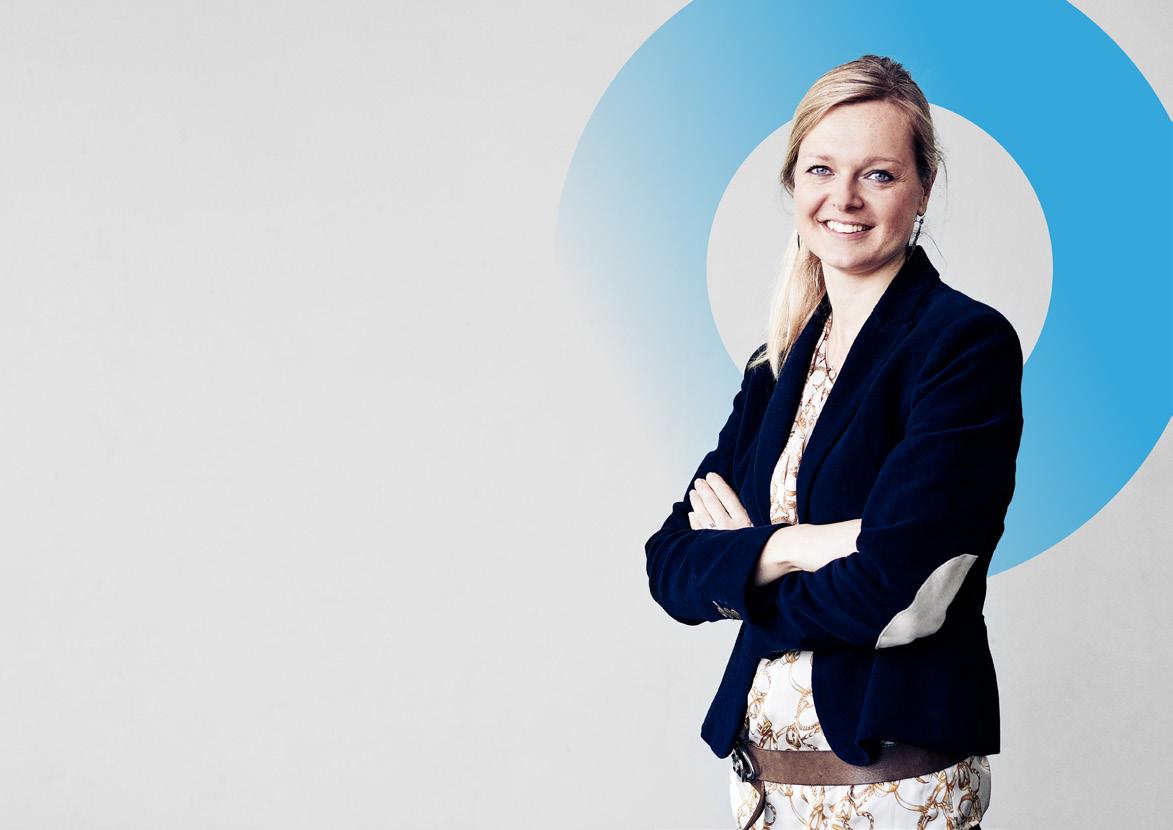
researches at Odense University Hospital and the University of Southern Denmark.
Michaela’s path to Funen and diabetes research was via a PhD from Charles University in Prague in 2010 and her first postdoctoral work at University of Massachusetts Medical School in Worcester, United States. “I always wanted to do clinical research, and the obesity/diabetes field, at that time when I was looking for a PhD position, was one of the most interesting topics.
I’m glad I’ve chosen this path”, she says.
During her PhD studies, the research focus was to study molecular adaptations of human adipose tissue (AT) in response to dietary treatment of obesity.
In 2011, Michaela moved from Prague to the postdoctoral position in Worcester. There she employed several animal models of obesity to study the role of macrophages in adipose tissue and liver in relation to complications of insulin sensitivity and lipid metabolism.
From the United States, Michaela moved to Funen where she has embarked on a second postdoc at the Danish Diabetes Academy, and she has established a new interdisciplinary area in the lab with a focus on bone and fat metabolism. Her research in Professor Moustapha Kassem’s group at Odense University Hospital allows her to combine expertise from the AT and energy metabolism field to stem cell and bone biology.
Michaela Tencerova
Page 49 Danish Diabetes Academy Booklet 2016
Sometimes sacrifices must be made in order to reach one’s goal
“Her project is highly relevant from a basic research point of view as well as for clinical application. The project will provide a mechanistic understanding of the role of bone marrow adipose tissue and bone in overall body metabolism under normal conditions and in patients with obesity or type 2 diabetes”, states Professor Moustapha Kassem.
Her plans are to build her own research group and create a good team that can work together. “Team work is one of the most important things in research”, she says and adds, “Also I would like to continue working towards improving the life of patients with metabolic diseases.”
Facts
Michaela Tencerova, MSc,PhD, postdoctoral fellow at the Danish Diabetes Academy from 2014 to 2017
Nationality: Slovak Project title: Characterization of BMAT in lean healthy and obese insulin resistant mice and humans
Workplace: Department of Endocrinology, Odense University Hospital
Principal Investigator: Professor Moustapha Kassem
Awards:
She works hard—and when she got the Young Basic Researcher Award 2014 from the Danish
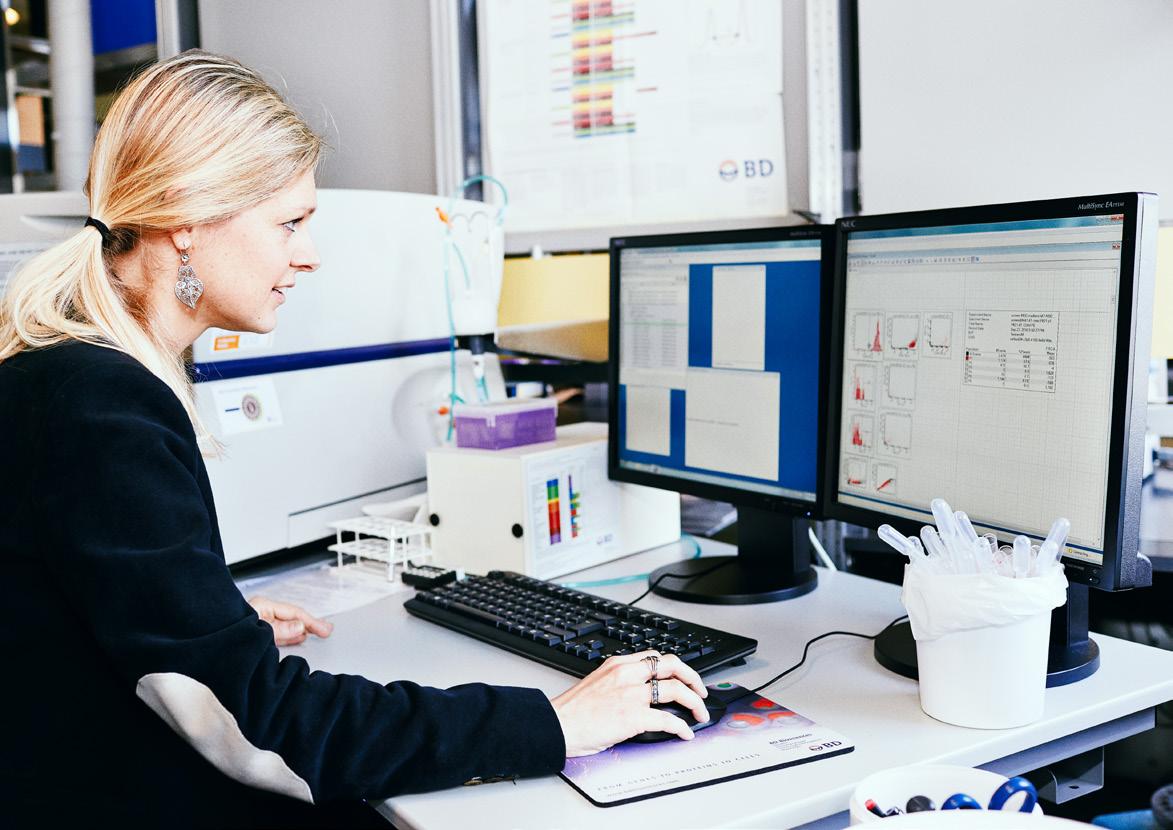
Diabetes Academy she said “It means that hard work pays off and it encourages me to continue the research. It makes the hard work of scientists meaningful and of value.”
Michaela takes an active part in the work of the Danish Diabetes Academy: She is helping organise the two-day symposium “Bone, Energy Metabolism and Diabetes” to be held in October 2016, and she also participated in the planning of the annual Winter School held in Malaga, Spain, in March 2017.
When asked ”What is your ultimate goal workwise?”, Michaela hesitates before replying “I don’t like putting myself in front of big goals because life always changes your path. But as a researcher I would like to continue doing
research which can bring benefits to society and combine all good aspects of it.”
One thing must be in the right place, no matter where she works and what she is doing: “To do this job, you need to be challenged every day when you come to work and the diabetes field brings it for sure.”
Danish Diabetes Academy Annual Award 2014Young Basic Researcher
LinkedIN: www.linkedin.com/in/ michaela-tencerova-99964737
„I don’t like putting myself in front of big goals because life always changes your path. But as a researcher I would like to continue doing research which can bring benefits to society and combine all good aspects of it”
Michaela Tencerova
Page 50 Danish Diabetes Academy Booklet 2016
A researcher with patents and a newly founded company to his credit
Mads Fuglsang Kjølby is only 38, but he has already achieved some admirable research goals. Together with colleagues, he has taken out patents on three of their inventions; and with five others, he has founded the company InsuSense Aps. All this whilst working at the Department of Biomedicine at Aarhus University.
The purpose of InsuSense is to develop and perfect new medicines to treat diabetes and obesity from a commercial standpoint –and with a licence from Aarhus University. Expectations are high: “We’re talking about a massive market with potentially 400 million patients around the globe”, Christian E. Elling, CEO of InsuSense, remarked in an interview with Børsen, a Danish business newspaper.
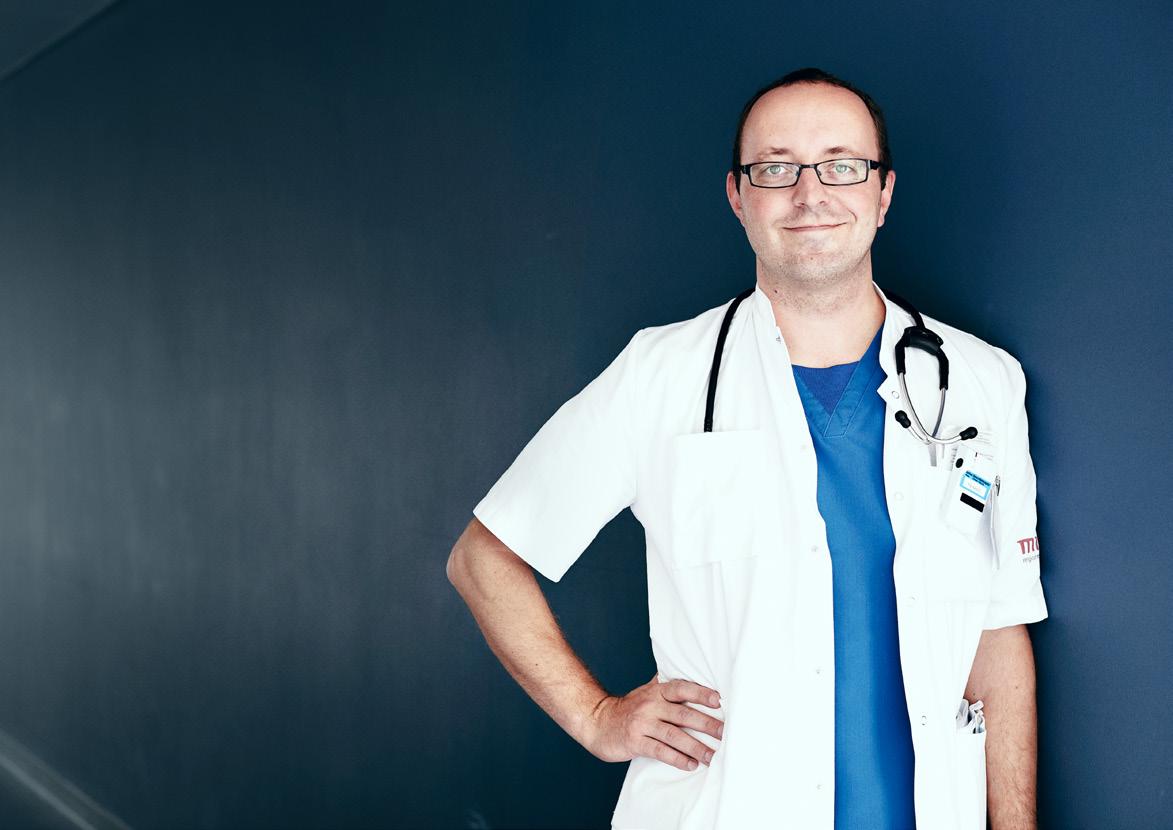
”Where almost all pharmacological treatment options in type 2 diabetes work by increasing insulin levels, either by stimulating secretion from pancreas or by replacement, this targets the problem insulin resistance. Our geneSorCS1 works by increasing insulin sensitivity in mice and cells and may thus offer a novel treatment option for patients with type 2 diabetes”, Mads Fuglsang Kjølby says.
One research finding —multiple potential applications
The company—and the results which gave rise to it—came from the group’s work on the sortilins and their significance in the development of cardiac disease. The findings were patented (application) in 2008 and sold to H. Lundbeck in 2009.
Later, their research took several directions, as many of the results were applicable in other areas. In 2010, the group discovered to their amazement that the proteins are significant in the development of type 2 diabetes. One connection was demonstrated in vivo showing that the SorCS1 gene has a direct effect on the number of insulin receptors in the organism. This led on to the discovery that, by adding a small fragment of the SorCS1 receptor exogenously, an increased number of insulin receptors were traceable. “In other words, SorCS1 is a new mechanism that can be used to develop drugs for people who lack insulin, such as patients with type 2 diabetes “, says Mads.
Page 53 Danish Diabetes Academy Booklet 2016
Mads Fuglsang Kjølby
Facts
Mads Fuglsang Kjølby, MD, PhD, postdoctoral fellow at the Danish Diabetes Academy from 2014 to 2017 Nationality: Danish Project title: SorCS1: a novel drug target in diabetes and obesity?
Workplace: Department of Biomedicine, Aarhus University
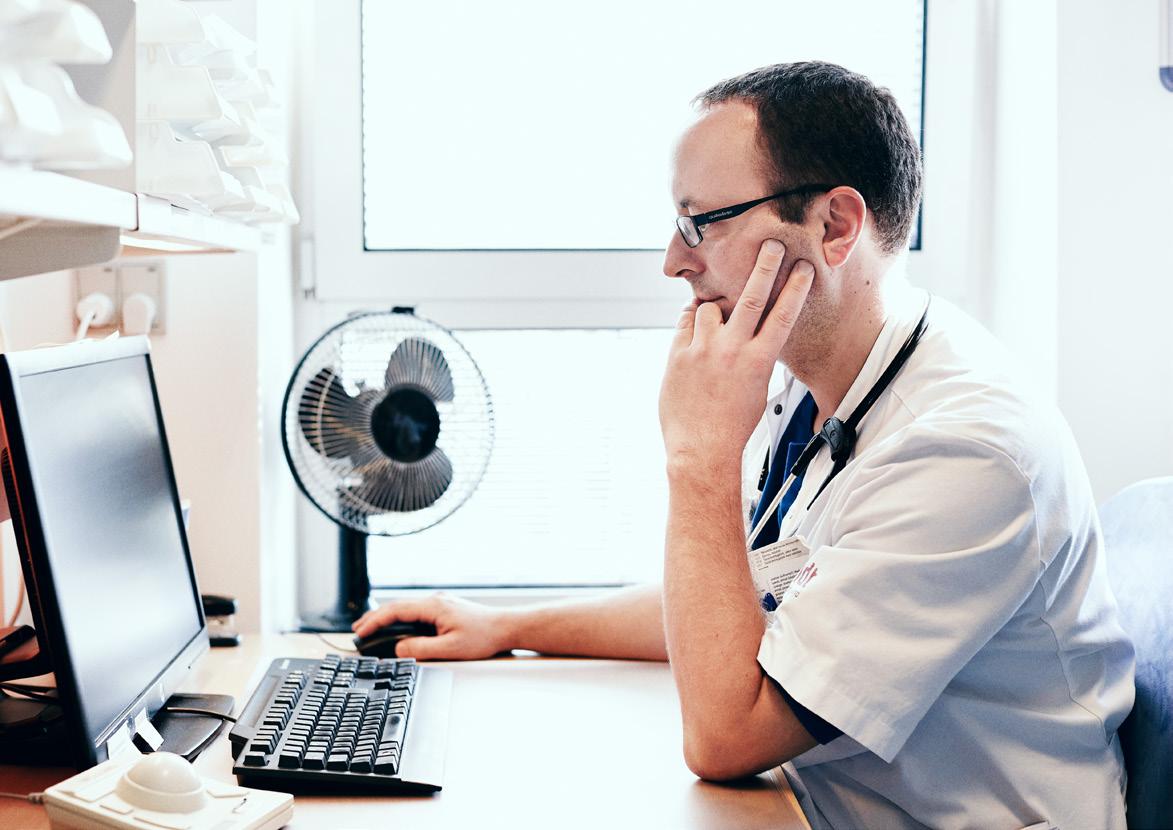
Principal Investigator: Professor Anders Nykjær
LinkedIN: www.linkedin.com/in/mkjolby
An early start in research
Mads has come far, but this is due in part to an early start on his research career, almost directly after he began to study medicine. “I trawled the internet and found opportunities at the University of Southern Denmark for early research. Then I contacted Professor Peter Bie”, says Mads. His explanation is quite simply that he found research extremely interesting; perhaps the fact that his elder sister, a dentist, was a researcher also inspired him.
His interest in diabetes is basically from their serendipity finding that SorCS1 can increase insulin sensitivity in tissue without acting as insulin itself.
”The mechanisms governing insulin sensitivity are for the most part unknown. Diabetes is a potential debilitating disease of great impact for the individual. Even though many treatment options are available, we still need constant improvement for managing diabetes in our therapeutic arsenal. Many diabetics still suffer from late complications of diabetes, such as neuropathy, retinopathy, increased atherosclerosis and following increased risk of stroke and acute myocardial infarction. My interest in diabetes is also personal as a close family member suffers from type 2 diabetes and the late complication, neuropathy”, he explains. The exciting paths of entrepreneurship and research have come about without Mads having
to live his life in laboratories. He reads, takes part in CrossFit activities in the woods with friends and enjoys leisure time with his three children and Birgitte, also a researcher and now a teacher at Aarhus Katedralskole, a general upper secondary school.
„In other words, SorCS1 is a new mechanism that can be used to develop drugs for people who lack insulin, such as patients with type 2 diabetes”
Mads Fuglsang Kjølby
Page 54 Danish Diabetes Academy Booklet 2016
12 Talented Researchers
– young diabetes researchers supported by the Danish Diabetes Academy
Responsible: Managing Director Tore Sønne Christiansen
Editing: Kirsten Bohl
Proof-reading: Tine Hylle
Translation: Dansk oversættelsesog sprogservice
Layout: OddFischlein I/S
Photos: Ida Schmidt
ISBN: 978-87-996346-7-5
Publisher: Danish Diabetes Academy, OUH, Sdr Boulevard 29, Entrance 112, 3rd floor, DK-5000 Odense C
Contact: Info@danishdiabetesacademy.dk
From the foreword
The Academy was established on 1 September 2012 with a five-year grant from the Novo Nordisk Foundation (2012-2017) of DKK 201,880,000 (EUR 27,059,485) with the aim to enhance the quality of Danish diabetes research and ensure that it remains at the highest international level in the future for the benefit of present and future generations of patients with diabetes. The Academy constitutes an original platform for a national diabetes research strategy ensuring both basic and clinical research in diabetes. The Academy is the first of its kind in Denmark and will recruit around 150 researchers during the first 5 years.
„We at the Danish Diabetes Academy are proud of these researchers and of the other 130 people we have been able to support in the four years since the Academy began its work ”
Danish Diabetes Academy

Funded by the Novo Nordisk Foundation






































